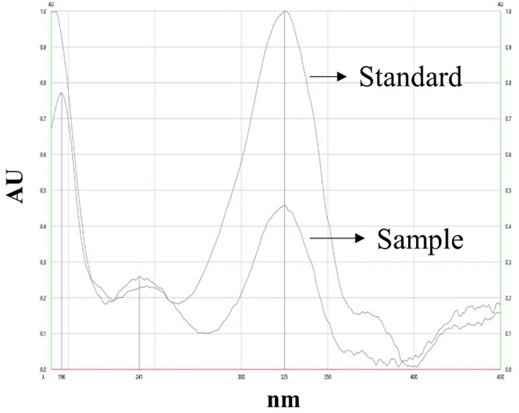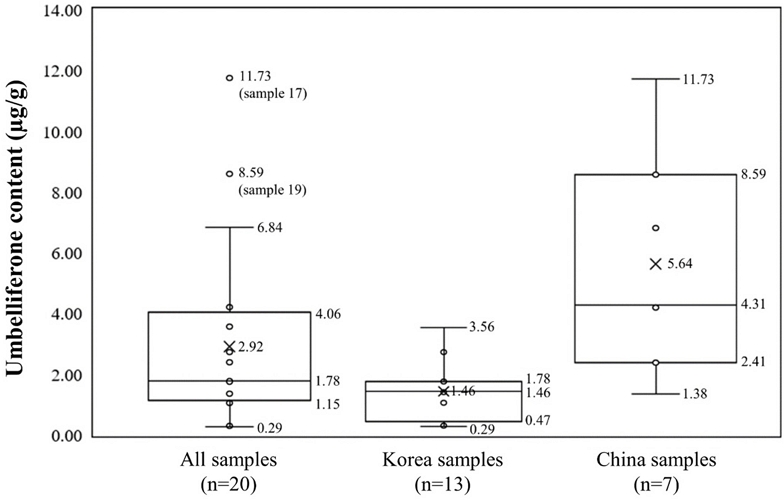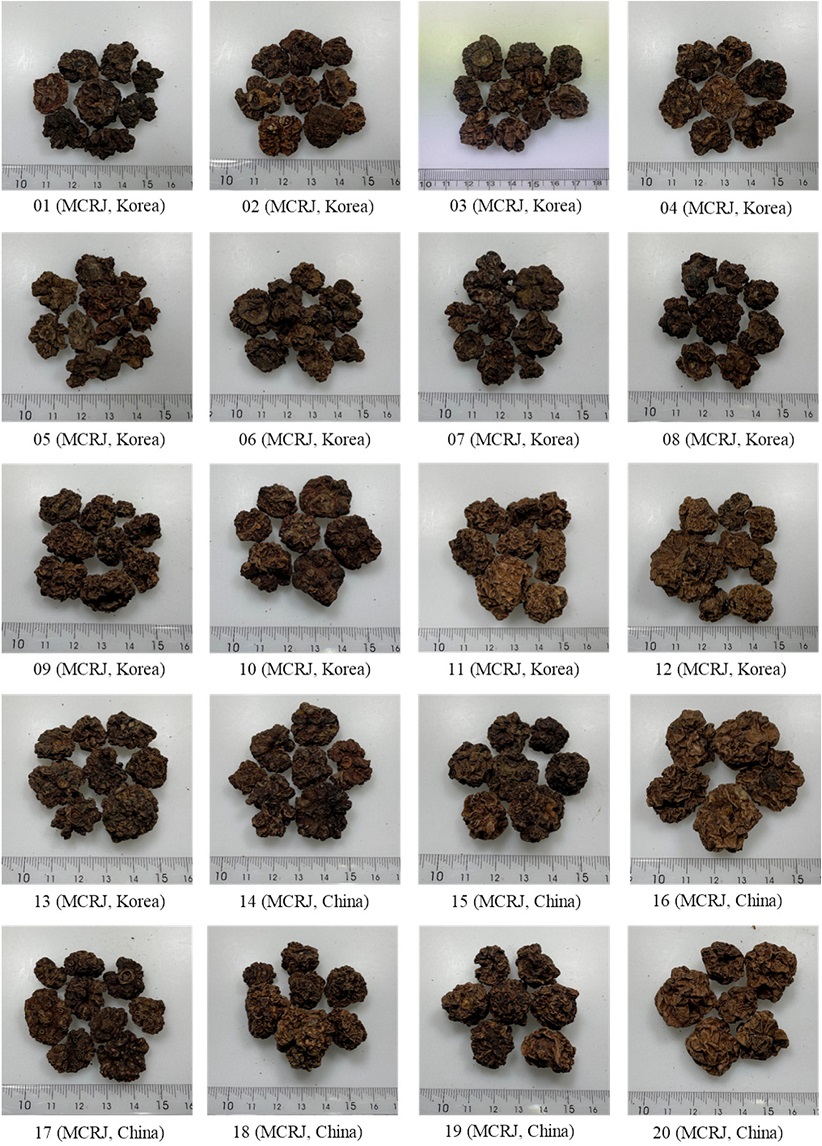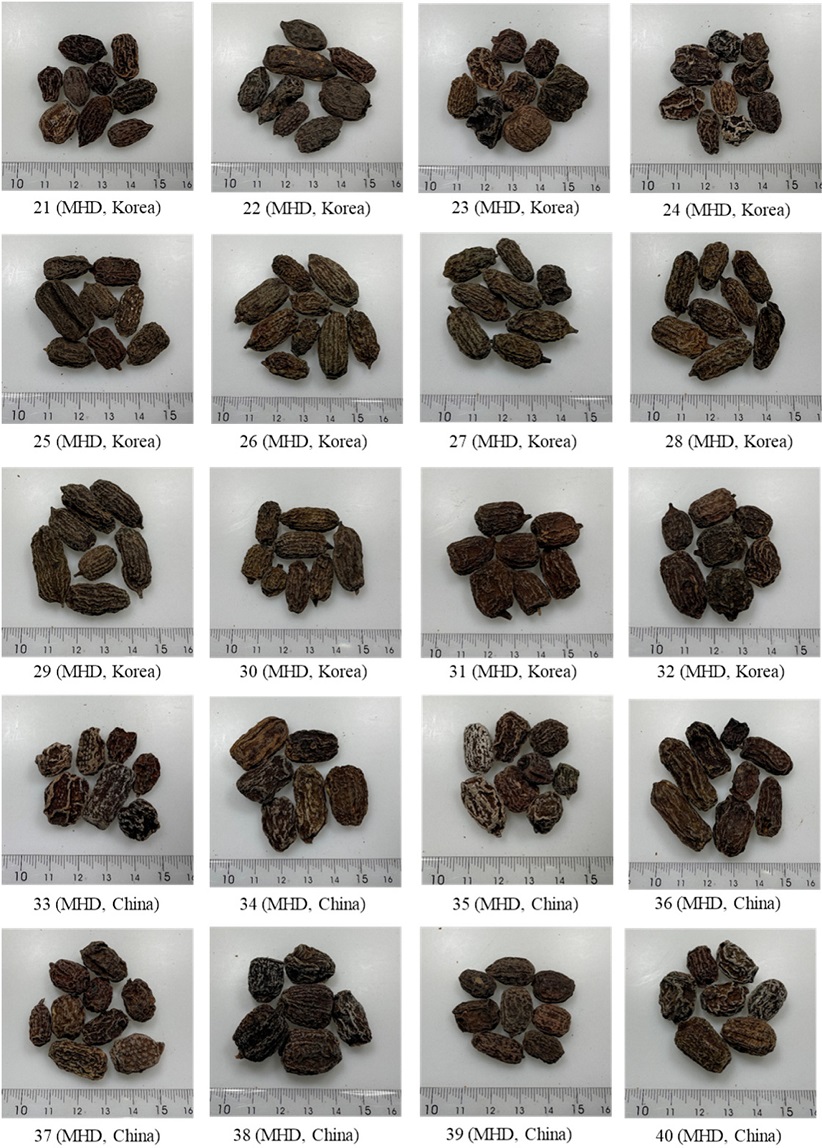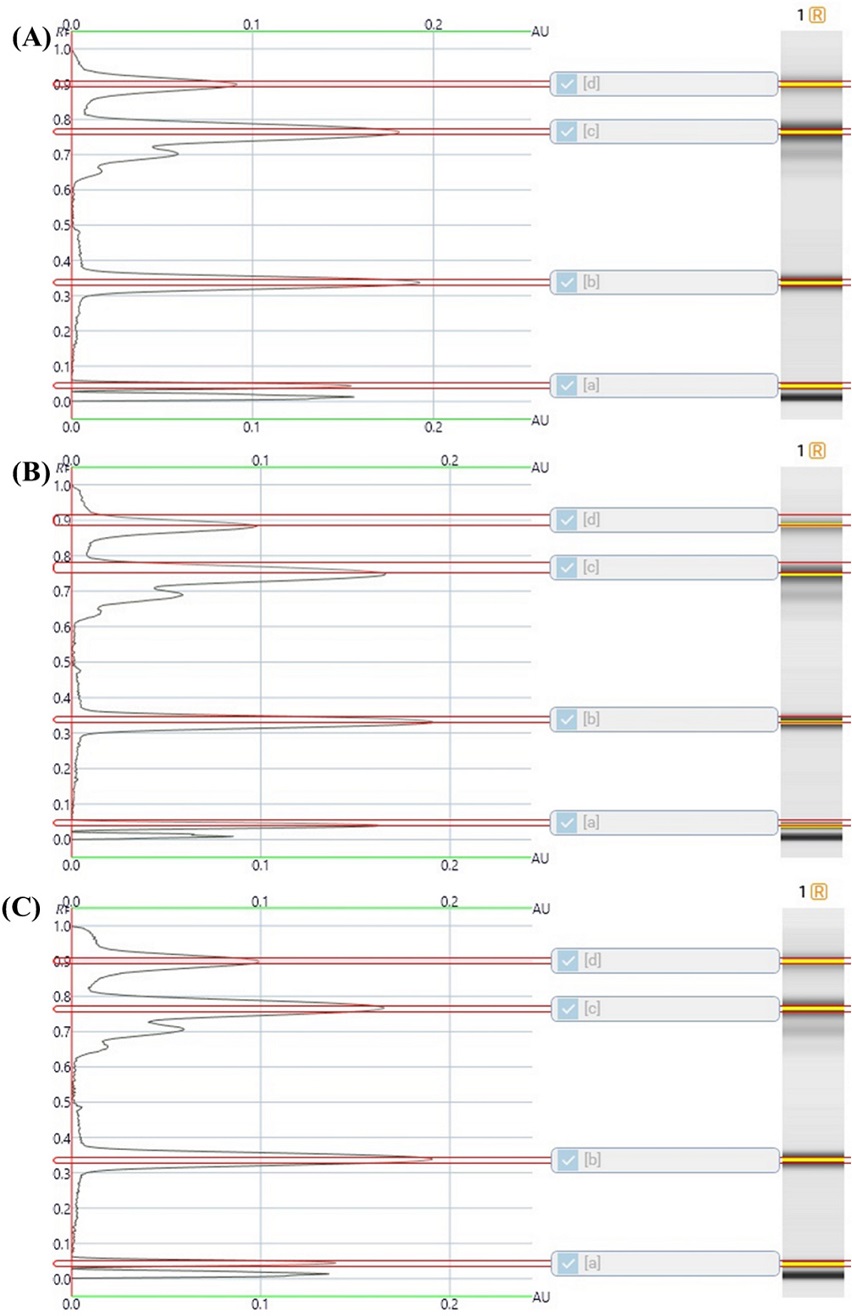
Development of High-performance Thin-layer Chromatography (HPTLC) Method for Quality Control of Actinidiae Fructus Vermicultus
Abstract
In this study, we have successfully established a high-performance thin-layer chromatography (HPTLC) method for the quality assessment of Actinidiae Fructus Vermicultus, known as Mokcheonryo(ja) in Korea. This is the dried vermiculate fruit of Actinidia polygama and A. kolomikta, as stipulated by the Korean Herbal Pharmacopoeia (KHP). However, the Korean herbal market often witnesses the inclusion and distribution of ‘Mihudo’, an alternative herbal product sourced from the dried fruits of A. arguta, belonging to the same botanical genus. This confluence has raised substantial apprehensions concerning the veracity of quality. In response to this concern, we have meticulously developed an HPTLC analytical methodology capable of differentiation between Mokcheonryo and Mihudo by exploiting their distinct chemical profiles. We identified umbelliferone as a key marker compound for Mokcheonryo and quantified the content of umbelliferone in each sample using a TLC scanner. Throughout this study, we confirmed distinct fingerprints for Mokcheonryo and Mihudo, providing a reliable means to differentiate between these two herbal medicines. Furthermore, the presence of umbelliferone in Mokcheonryo serves as an indicator compound for quality assessment. The proposed HPTLC method offers a practical and effective tool for ensuring the quality and authenticity of Mokcheonryo in the herbal market.
Keywords:
High-performance Thin-layer Chromatography (HPTLC), Quality Control, Identification Test, Actinidia Fructus Vermicultus, UmbelliferoneIntroduction
Herbal medicines have been a cornerstone in the prevention and treatment of human diseases for centuries.1 Among the myriad of herbal medicines available, fruits from the Actinidia species have garnered global recognition for their palatable taste coupled with various pharmacological effects.2 Actinidia polygama (Siebold & Zucc.) Planch. ex Maxim., a representative herbal medicine of the Actinidia species, is widely used, particularly in Korea and Japan.3 Its vermiculate fruits, known as Mokcheonryo (ja), are primarily used as medicinal materials in Korea.
Within the context of the Korean Herbal Pharmacopoeia (KHP),4 both “Mokcheonryo (MCR)” and “Mokcheonryoja (MCRJ)” are collectively referred to as “Mokcheonryo”. However, it's important to note the nuanced distinction: MCR encompasses the branch and leaves, while MCRJ specifically denotes the fruit that has undergone insect consumption. In light of this differentiation, our study endeavors to provide distinct delineations for both MCR and MCRJ, with a particular emphasis on elucidating the attributes of MCRJ. The source plants of MCRJ are Actinidia polygama (Siebold & Zucc.) Planch. ex Maxim. and A. kolomikta (Maxim.) Maxim. (Family Actinidiaceae), while A. arguta (Siebold & Zucc.) Planch. ex Miq., although a congeneric plant, is not the source plant of MCRJ, thus it is considered a counterfeit. The fruit of A. arguta is used as a medicinal material known as “Mihudo (MHD)”, but the issue arises when it is distributed as a counterfeit of MCRJ.
MCRJ has earned traditional acclaim for its noteworthy efficacy in addressing ailments such as rheumatoid arthritis and gout. Additionally, it demonstrates effectiveness against conditions like abdominal pain and constipation.5 In contrast, MHD, colloquially known as the hardy kiwi, is recognized for its potency in alleviating severe thirst, chest congestion, and fever, exerting beneficial effects on both the nerves system and the gastric tract. Its historical utilization is documented in traditional texts such as “Bonchogangmok”6 and “Donguibogam”.7
According to the study by Khromykh et al.,8 the principal compounds present in both extracts were 2-propenoic acid, pentadecyl ester, followed by squalene, 7,9-di-tert-butyl-1-oxaspiro(4,5)deca-6,9-dien-2,8-dione, octadecanoic acid, 2-oxo-methyl ester, ethylisoallocholate, and phytol. These compounds have gained recognition for their notable bioactive properties. Notably, the concentration of these compounds exhibited variations between the two species. This divergence accentuates the distinctive therapeutic profiles inherent to the herbal medicines MCRJ and MHD, thus underscoring the imperative for precise differentiation between them.
Currently, MCR(J) is not listed in other countries’ pharmacopoeias, such as Japanese Pharmacopeia 18th (JP), Pharmacopeia of the People’s Republic of China 2020 (ChP), Hong Kong Chinese Materia Medica Standards (HKCMMS), Taiwan Herbal Pharmacopeia (THP), etc., and its identification criteria are not established in KHP. This lack of standardization leads to a heavy reliance on morphological evaluation for quality control. The physical appearance of MCRJ and MHD is quite similar, albeit with certain differences. MCRJ presents a yellowish-brown, oval shape with a rough exterior. MHD, while also oval in shape, displays a color closer to black and its surface roughness is less pronounced compared to MCRJ. However, morphological evaluation alone may not be sufficient to ensure the quality and authenticity of herbal medicines. There have been cases where some herbal medicine markets erroneously sell ‘MHD’ as ‘MCRJ’. Fig. 1 displays representative appearances of MCRJ and MHD.
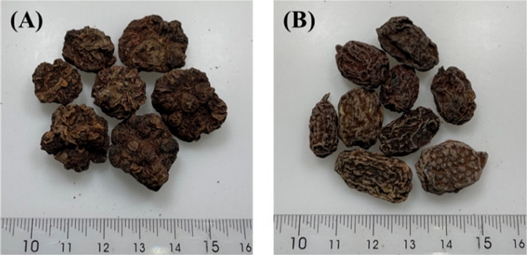
Representative morphologic features of the dried vermiculate fruits of Actinidia polygama (A) and the dried fruits of A. arguta (B).
High-performance thin-layer chromatography (HPTLC) offers a solution to these challenges. HPTLC, an advanced form of thin-layer chromatography (TLC), is widely employed due to its simplicity, high speed, flexibility, and sensitivity.9-11 It stands as an efficient and dependable technique for analyzing intricate mixtures found in herbal medicines, revealing their chemical fingerprints.11 It allows for the simultaneous analysis of multiple samples, providing a comprehensive overview of the chemical composition of the samples. Hence, HPTLC has traditionally been employed for the qualitative analysis of herbal medicines.12 However, recent advancements in HPTLC technology have broadened its abilities, enabling it to not just identify but also measure specific compounds in herbal medicines.13,14
While the use of HPTLC for chemical fingerprinting of herbal medicines has been successfully implemented, there have been no studies reporting on the chemical fingerprint differentiation between MCRJ and MHD. Thus, our objective was to develop an HPTLC method to distinguish the chemical fingerprint between these two herbal medicines, providing a practical and effective tool for ensuring its quality and authenticity in the herbal market.
Experimental
Materials and reagents – A total of 40 samples labeled as either MCRJ or MHD were purchased from Korean herbal medicine market. Their authenticity was confirmed by Dr. Young Pyo Jang, one of the authors. The information on the samples is shown in Table 1 and morphologic images are provided in supplementary data (Fig. S1 and Fig. S2). Umbelliferone (7-hydroxycoumarin, CAS 93-35-6, purity 99.0%) was purchased from Sigma-Aldrich (Steinheim, Germany).
For a system suitability test (SST), the Universial HPTLC mix (UHM)15,16, which consists of guanosine, sulisobenzone, thymidine, paracetamol, phthalimide, 9-hydroxyfuorene, thioxanthen-9-one and 2-(2H-benzotriazol-2-yl)- 4-(1,1,3,3 tetramethylbutyl)-phenol, was used. The UHM was provided by CAMAG (Muttenz, Switzerland). Silica gel 60 F254 HPTLC plate (20 × 10 cm) and Silica gel 60 HPTLC plate (20 × 10 cm) were sourced from Merck (Darmstadt, Germany). Dichloromethane and acetone (extra pure grade) were procured from Duksan Pure Chemicals Co., Ltd. (Ilsan, Republic of Korea). Formic acid (99.0%) was obtained from Daejung Chemicals & Metals co. Ltd. (Siheung, Republic of Korea).
Instruments – The HPTLC analysis was conducted using a CAMAG (Muttenz, Switzerland) equipment operated with visionCATS 3.2 software. The CAMAG equipment included a Linomat 5 applicator with a 100 µL syringe (Hamilton, Bonaduz, Switzerland) for sample application, TLC visualizer 3 for visualizing the chromatograms, TLC scanner 4 for quantification of the standard compound, automatic developing chamber (ADC) 2 with humidity control for the development of the chromatograms. Chromatographic separation was carried out on HPTLC Silica gel 60 plates (20 × 10 cm, Merck, Darmstadt, Germany) with F254 fluorescent indicator for visualizing chromatograms. However, for scanning purposes, plates without the fluorescent indicator were used. For Mass spectrometry study, CAMAG TLC-MS-Interface was utilized to extract the compounds that can either differentiate MCRJ from MHD or are common to both, on the HPTLC plate and injected into the Mass spectrometer. A JMS-T100TD (AccuToF-TLC) mass spectrometer from JEOL Ltd., (Tokyo, Japan) was used, operating in Electrospray ionization (ESI) mode.
Preparation of sample and standard solutions – The samples were finely pulverized and then passed through an 850 µm sieve for particle size homogenization. Next, 4.0 g of each powdered sample was extracted with 10 mL methanol by sonication for 30 minutes (Powersonic 620, Hwashin Tech., Daegu, Republic of Korea). The extract was filtered using a filter paper (110 mm pore size, Hyundai micro, Republic of Korea) and subsequently evaporated under reduced pressure using a rotary evaporator (NVC-2100, EYELA, Japan). The residue was dissolved in 1 mL of methanol and filtered through a 0.45 μm polytetrafluoroethylene (PTFE) syringe filter. For the preparation of the standard solution, umbelliferone was precisely weighed and dissolved in methanol to achieve a concentration of 100 µg/mL. The standard solution was also filtered through a 0.45 µm PTFE syringe filter.
HPTLC analysis conditions – each applied as 2 μL, forming 8 mm bands spaced 4 mm apart and positioned 8 mm from the lower edge of the plate. The plate was then developed to a distance of 70 mm using a developing solvent system composed of dichloromethane-acetone-formic acid (4:1:0.1, v/v/v). Prior to development, the CAMAG glass twin through chamber (20 × 10 cm, CAMAG, Muttenz, Switzerland) was saturated for 20 minutes with a filter paper. The development process was conducted at a controlled temperature of 20 ± 5oC and relative humidity of 33 ± 5% using a saturated solution of MgCl2. The developed plates were observed under a TLC visualizer under UV 366 nm. Subsequently, the plates were scanned at 330 nm in absorbance mode at 20 mm/s scanning speed, data resolution of 100 µm/step, and slit size of 5 ± 0.2 mm, micro. For obtaining UV spectra of umbelliferone between 200 and 450 nm in absorbance mode, a deuterium and tungsten lamp were used with a scanning speed of 20 mm/s and a slit size of 5 × 0.2 mm, micro.
MS analysis conditions – For the MS analysis conducted in the positive ion mode, the parameters were set with a peak voltage of 1000 V, detector voltage of 2000 V, orifice 1 voltage of 40 V, orifice 1 temperature of 80oC, orifice 2 voltage of 10 V, and ring lens voltage of 5 V. The desolvating chamber was maintained at a temperature of 250oC. N2 gas is utilized at a flow rate of 1.0 L/min for nebulizing, and 3.0 L/min for desolvating. The acquired m/z range spanned from 50 to 1000. Before embarking on exact mass measurements, the mass scale was calibrated using the Yokudelna calibration kit from JEOL. The TLC-MS-interface extracted the targeted bands on the plate using a 1% acetic acid in 80% methanol solvent, with a flow rate of 0.1 L/min.
Results and Discussion
The optimal HPTLC method was devised for the identification of MCRJ and MHD. Among the Actinidia species, only eleven coumarins have been reported, with umbeliferone confirmed exclusively in A. polygama.17,18 As a result, we chose umbeliferone as the marker compound to differentiate MCRJ from MHD. The most effective mobile phase ensuring the appropriate retardation factor (Rf) value for umbelliferone and clear separation was a mixture of dichloromethane-acetone-formic acid (99.0%) in a ratio of 4:1:0.1 (v/v/v).
To assess the consistency across individual HPTLC pleates, an SST was executed using UHM. Under the prescribed HPTLC conditions, the chromatogram of HM was distinctly visible at UV 254 nm. Among the observed spots, the four most pronounced were selected as reference bands in ascending order based on their Rf value. The reference Rf values for these spots were established at 0.047, 0.339, 0.765, and 0.900, respectively, with the Rf values of each spot observed to deviate by no more than 0.02 Rf units. Detailed results from the SST are available in the supplementary data (Table S1 and Fig. S2).
The developed HPTLC analysis unveiled unique fingerprints for both MCRJ and MHD, presenting a dependable method for distinguishing these two herbal medicines. As depicted in Fig. 2, a blue fluorescent band at an Rf 0.610, consistent with umbelliferone, was observed in all 20 samples of MCRJ under UV 300 nm. This zone was absent in the 20 samples of MHD. Upon examining the UV spectra of the blue fluorescent band (Rf 0.610) in the chromatograms of both the standard and samples using the TLC scanner, we found that their profiles closely matched each other, as illustrated in Fig. 3. This can be attributed to the traditional use of MCRJ for the treatment of rheumatoid arthritis and gout, stemming from umbelliferone's anti-rheumatic effects and its potent inhibitory effect on lipopolysaccharide (LPS)-induced inflammatory bone loss.19,20
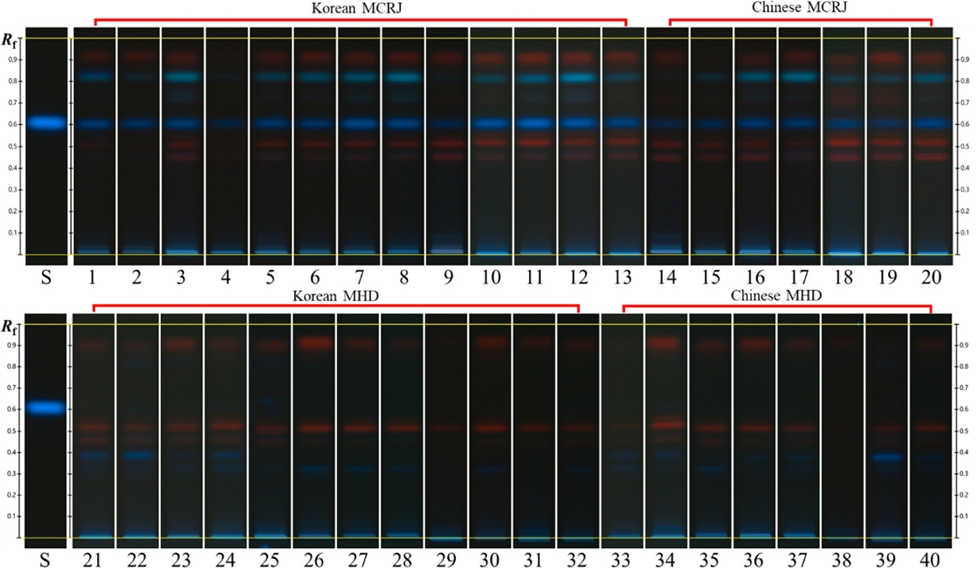
HPTLC chromatogram of MCRJ (1-20) and MHD (21-40) analyzed with the proposed method under UV 366 nm; S, Umbeliferone (100 µg/mL).
In a further exploration of the HPTLC fingerprints using the TLC-MS-interface, we sought to elucidate mass information of bands that distinguish MCRJ from MHD and those that are shared between the two. To conduct the MS analysis, both MCRJ and MHD samples, each of 8 µL, were placed on a single plate with 8 mm band length, and then processed according to the proposed method. As shown in Fig. 4, our focus was directed towards three specific bands: a turquoise fluorescent band at Rf 0.82 (A) found only in MCRJ, a red-colored band at Rf 0.51 (B) that appeared in both MCRJ and MHD, and a faint blue band at Rf 0.38 (C) that was unique to MHD. In the ESI-MS in positive mode, distinct characteristic ions were observed. Band (A) displayed ions [M+Na]+ at m/z 189.08607 and [2M+Na]+ and m/z 355.18692. For band (B), the ion [M+Na]+ was detected at m/z 191.10199, and band (C) showed [M+H]+ at m/z 353.26579 and [M+Na]+ at m/z 375.24909. Upon consulting a review on the compounds found in Actinidia species17, it was inferred that band (A), represented by C10H14O2, could be either actinidialactone or neonepetalacotone. Meanwhile, band (B) with the molecular formula C10H16O2 was potentially indicative of dihydronepetalactone, iridomyrmecin, or isoiridomyrmecin.17,21 However, a substance bearing the molecular formula C21H36O4, as observed in band (C), has not been reported in plants of the Actinidia genus.
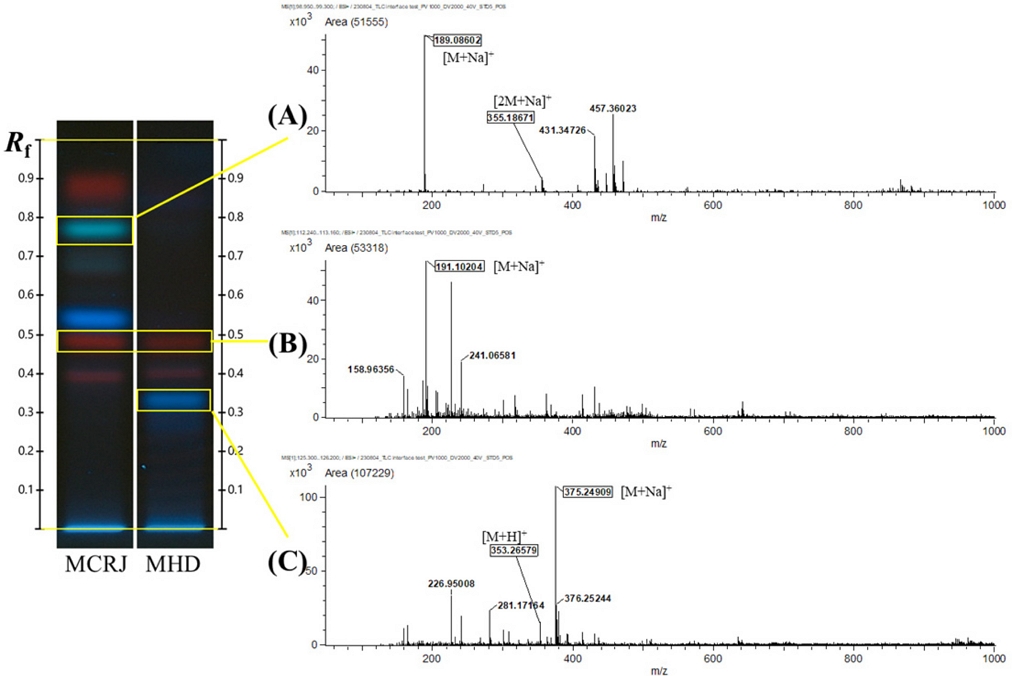
ESI-TOF-MS spectra of the three bands in chemical fingerprints of MCRJ and MHD; a turquoise fluorescent band at Rf 0.82 (A), a red-colored band at Rf 0.51 (B), and a faint blue band at Rf 0.38 (C).
To comprehend the current content of umbelliferone in commercially available MCRJ, a quantification evaluation was carried out. For the calibration curve, 100 µg/mL umbelliferone standard solution stock underwent serial dilutions using methanol, resulting in concentrations of 3.125, 6.25, 12.5, 25, and 50 µg/mL. Each of these five concentrations was applied three times on a single HPTLC plate. The area corresponding to various concentrations of umbelliferone was measured and the resulting calibration curve showed remarkable linearity (Table 2).
The content (µg/g) of umbelliferone in MCRJ was calculated from the linearity curve (Table 3). The average of 20 samples was 2.92 µg/g. However, the Box plot depicted in Fig. 5 reveals a broad distribution of umbelliferone content, with a standard deviation (SD) of 3.00. Particularly, samples 17 and 19 stand out as outliers in the entire data set. When these outliers are excluded, the mean content of umbelliferone is 2.12 µg/g, with SD of 1.70. For the Korean MCRJ samples (n=13), there was minimal fluctuation in content, with an average of 1.45 µg/g, indicating that umbelliferone content was lower than Chinese MCRJ samples. However, for the Chinese samples, further investigation is required because the number of samples is not sufficient to reflect their variability.
In conclusion, using the proposed HPTLC method, the chemical profiles of MCRJ and MHD can be quickly and easily verified and compared, and offers a practical and effective tool for ensuring the quality and authenticity of MCRJ in the herbal market. This research could serve as a foundation for quality assessment in the drug development process using MCRJ with further studies on the content criteria of umbelliferone and bioactivities of MCRJ.
Acknowledgments
This study was funded by a grant (00000MFDS000) from the Ministry of Food and Drug Safety in 2022-2023.
Conflicts of Interest
The authors declare that they have no conflicts of interest.
References
-
Li, Y.; Shen, Y.; Yao, C. L.; Guo, D. A. J. Pharm. Biomed. Anal. 2020, 185, 113215.
[https://doi.org/10.1016/j.jpba.2020.113215]

-
Panishcheva, D.; Motyleva, S.; Kozak, N. Slovak J. Food Sci. 2021, 15, 723-731.
[https://doi.org/10.5219/1682]

-
Takahashi, W.; Sugawara, F.; Yamamoto, N.; Bando, E.; Matsushita, J.; Tanaka, O. J. Forest Res. 2004, 9, 85-88.
[https://doi.org/10.1007/s10310-003-0053-z]

- Herbal Medicine Policy Division. Korean Herbal Pharmacopoeia; Ministry of Food and Drug Safety, Korea, 2022.
-
Ren, J.; Han, E. J.; Chung, S. H. Arch. Pharm. Res. 2007, 30, 708-714.
[https://doi.org/10.1007/BF02977632]

- Shizhen, L. Bon Cho Gang Mok: Compendium of materia medica; ChungKuK ChungEuiHak: China, 1978.
- Yoon, S.; Kim, H. Donguibogam; Donguibogam Publishing Company: Korea, 2006, pp 297-2189.
-
Khromykh, N. O.; Lykholat, Y. V.; Didur, O. O.; Sklyar, T. V.; Davydov, V. R.; Lavrentievа, K. V.; Lykholat, T. Y. Biosystems Diversity 2022, 30, 39-45.
[https://doi.org/10.15421/012205]

-
Di, X.; Chan, K. K.; Leung, H. W.; Huie, C. W. J. Chromatogr. A 2003, 1018, 85-95.
[https://doi.org/10.1016/j.chroma.2003.07.015]

-
Goswami, A. K.; Gogoi, N.; Shakya, A.; Sharma, H. K. J. Chromatogr. Sci. 2019, 57, 411-417.
[https://doi.org/10.1093/chromsci/bmz009]

-
Liang, Y. Z.; Xie, P.; Chan, K. J. Chromatogr. B. Analyt. Technol. Biomed. Life Sci. 2004, 812, 53-70.
[https://doi.org/10.1016/S1570-0232(04)00676-2]

-
Nicoletti, M. Rev. Bras. Farmacogn. 2011, 21, 818-823.
[https://doi.org/10.1590/S0102-695X2011005000131]

- Champati, B. B.; Padhiari, B. M.; Ray, A.; Jena, S.; Sahoo, A.; Sahoo, T.; Panda, P. C.; Nayak, S. Plant Science Today 2023, 10, 345-353.
-
Rodríguez-Valdovinos, K. Y.; Salgado-Garciglia, R.; Vázquez-Sánchez, M.; Álvarez-Bernal, D.; Oregel-Zamudio, E.; Ceja-Torres, L. F.; Medina-Medrano, J. R. Plants 2021, 10, 475.
[https://doi.org/10.3390/plants10030475]

-
Do, T. K. T.; Schmid, M.; Phanse, M.; Charegaonkar, A.; Sprecher, H.; Obkircher, M.; Reich, E. J. Chromatogr. A 2021, 1638, 461830.
[https://doi.org/10.1016/j.chroma.2020.461830]

-
Schmid, M.; Do, T. K. T.; Trettin, I.; Reich, E. J. Chromatogr. A 2022, 1666, 462863.
[https://doi.org/10.1016/j.chroma.2022.462863]

-
Ma, J. T.; Li, D. W.; Liu, J. K.; He, J. Nat. Prod. Bioprospect. 2021, 11, 537-609.
[https://doi.org/10.1007/s13659-021-00319-8]

- Lu, J.; Cui, G.; Wang, X.; Zhu, N.; Liu, G.; Li, X.; Jin, Y. Chinese Pharmaceutical Journal 2009, 44, 328-330.
-
Cai, L.; Zhou, M. Y.; Hu, S.; Liu, F. Y.; Wang, M. Q.; Wang, X. H.; Jiang, F.; Feng, X. W.; Liu, X. S.; Li, R. Am. J. Chin. Med. 2022, 50, 1945-1962.
[https://doi.org/10.1142/S0192415X22500835]

-
Kwak, S. C.; Baek, J. M.; Lee, C. H.; Yoon, K. H.; Lee, M. S.; Kim, J. Y. Int. J. Biol. Sci. 2019, 15, 2427-2437.
[https://doi.org/10.7150/ijbs.28609]

-
Bol, S.; Scaffidi, A.; Bunnik, E. M.; Flematti, G. R. BMC Biol. 2022, 20, 192.
[https://doi.org/10.1186/s12915-022-01369-1]


